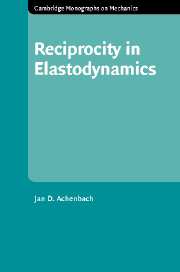Book contents
- Frontmatter
- Contents
- Preface
- 1 Introduction
- 2 Some elastodynamic theory
- 3 Wave motion in an unbounded elastic solid
- 4 Reciprocity in acoustics
- 5 Reciprocity in one-dimensional elastodynamics
- 6 Reciprocity in two- and three-dimensional elastodynamics
- 7 Wave motion guided by a carrier wave
- 8 Computation of surface waves by reciprocity considerations
- 9 Reciprocity considerations for an elastic layer
- 10 Forced motion of an elastic layer
- 11 Integral representations and integral equations
- 12 Scattering in waveguides and bounded bodies
- 13 Reciprocity for coupled acousto-elastic systems
- 14 Reciprocity for piezoelectric systems
- References
- Index of cited names
- Subject index
3 - Wave motion in an unbounded elastic solid
Published online by Cambridge University Press: 10 December 2009
- Frontmatter
- Contents
- Preface
- 1 Introduction
- 2 Some elastodynamic theory
- 3 Wave motion in an unbounded elastic solid
- 4 Reciprocity in acoustics
- 5 Reciprocity in one-dimensional elastodynamics
- 6 Reciprocity in two- and three-dimensional elastodynamics
- 7 Wave motion guided by a carrier wave
- 8 Computation of surface waves by reciprocity considerations
- 9 Reciprocity considerations for an elastic layer
- 10 Forced motion of an elastic layer
- 11 Integral representations and integral equations
- 12 Scattering in waveguides and bounded bodies
- 13 Reciprocity for coupled acousto-elastic systems
- 14 Reciprocity for piezoelectric systems
- References
- Index of cited names
- Subject index
Summary
Introduction
In this chapter the equations governing linear, isotropic and homogeneous elasticity are used to describe the propagation of mechanical disturbances in elastic solids. Some well-known wave-propagation results are summarized as a preliminary to their use in subsequent chapters.
There are essential differences between waves in elastic solids and acoustic waves in fluids and gases. Some of these differences are exhibited by plane waves. For example, two kinds of plane wave (longitudinal and transverse waves) can propagate in a homogeneous, isotropic, linearly elastic solid. These waves may propagate independently, i.e., uncoupled, in an unbounded solid. Generally, longitudinal and transverse waves are however, coupled by conditions on boundaries. Most boundary conditions or internal source mechanisms generate both kinds of wave simultaneously.
Plane waves in an unbounded domain are discussed in Section 3.2. The flux of energy in plane time-harmonic waves is considered in Section 3.3. The presence of a surface gives rise to reflected waves. The details of the reflection of plane waves incident at an arbitrary angle on a free plane surface are discussed in Section 3.4. As is well known, the incidence of a plane wave, say a longitudinal wave, gives rise to the reflection of both a longitudinal and a transverse wave. This wave-splitting effect happens, of course, also for an incident transverse wave. The reflection coefficients and other relevant results are listed in Section 3.4. Energy partition due to wave splitting is discussed in Section 3.5.
The most important elastic wave field is the basic singular solution.
- Type
- Chapter
- Information
- Reciprocity in Elastodynamics , pp. 30 - 54Publisher: Cambridge University PressPrint publication year: 2004

